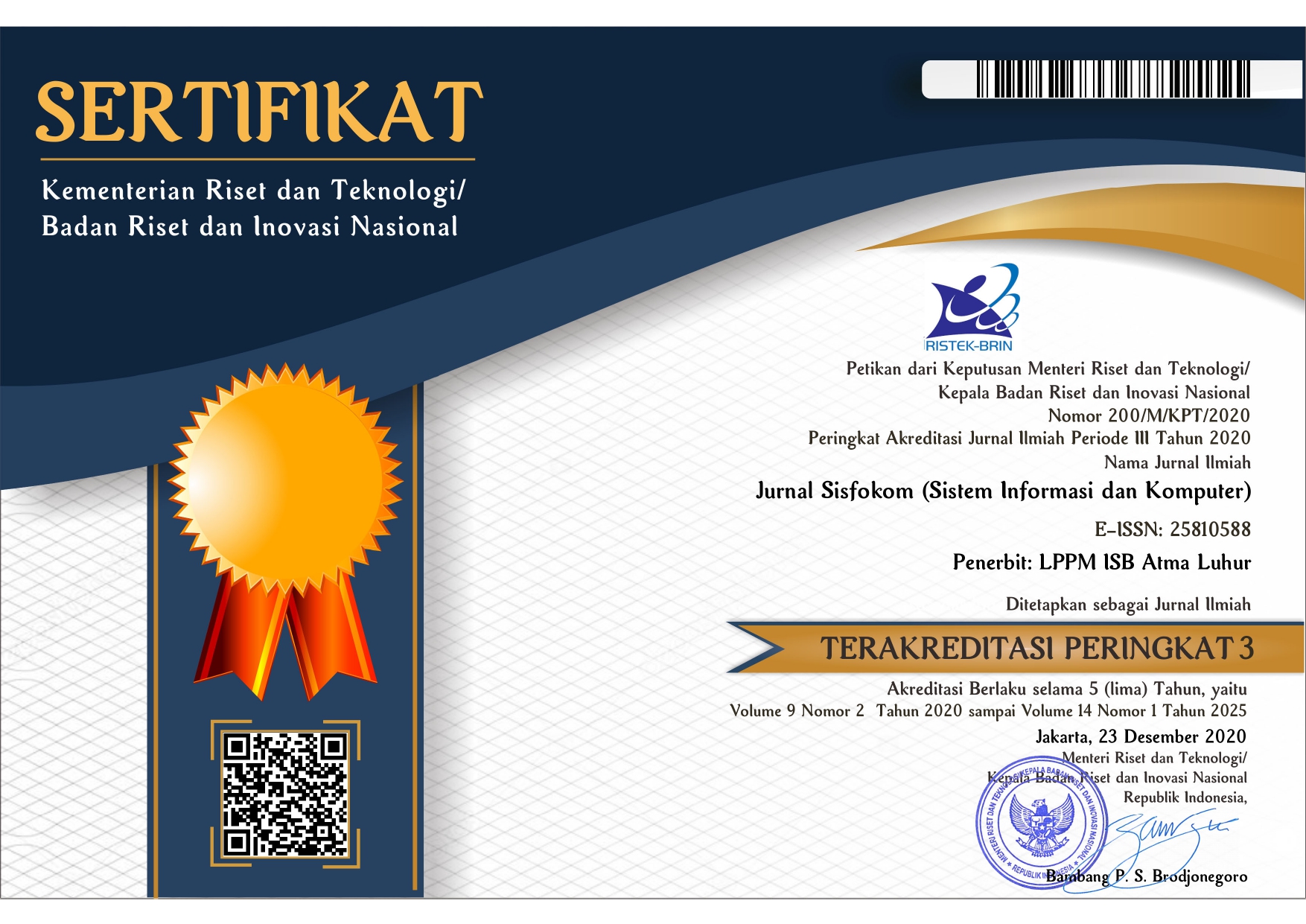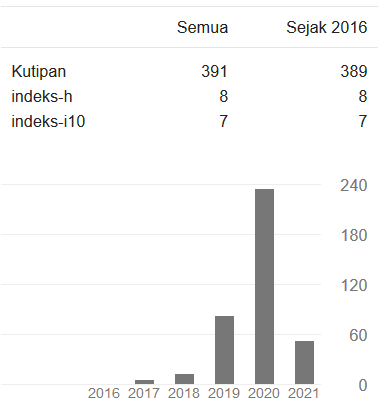Implementation of Modified Backpropagation with Conjugate Gradient as Microarray Data Classifier with Binary Particle Swarm Optimization as Feature Selection for Cancer Detection
DOI:
https://doi.org/10.32736/sisfokom.v9i3.978Keywords:
Microarray, Data Mining, Backpropagation, Conjugate Gradient, Binary Particle Swarm Optimization, Data ClassificationAbstract
Cancer is one of the deadliest diseases in the world that needs to be handled as early as possible. One of the methods to detect the presence of cancer cells early on is by using microarray data. Microarray data can store human gene expression and use it to classify cancer cells. But one of the challenges of using microarray is its vast number of features, not proportional to its small number of samples. To resolve that problem, dimensionality reduction is needed to reduce the number of features stored in microarray data. Binary Particle Swarm Optimization (BPSO) is one of the methods to reduce dimensionality of microarray data that can increase classification performance. Although when combined with Backpropagation, BPSO still shows a relatively low performance. In this research, Modified Backpropagation with Conjugate Gradient is used to classify data that has been reduced with BPSO. The average accuracy result of BPSO+CGBP is 86.1%, giving it an improvement compared to BPSO+BP which averaged to 80.8%.References
W. H. Organization, “Cancer fact sheet,” September 2019. [Online]. Available: http://www.who.int/news-room/fact-sheets/detail/cancer. [Accessed 18 September 2019]
Purbolaksono, M.D., Widiastuti, K.C., Adiwijaya, Mubarok, M.S., and Ma’ruf, F.A., 2017. Implementation of Mutual Information and Bayes Theorem for Classification Microarray Data. In Journal of Physics: Conference Series (Vol.921, No.1, p. 012011). IOP Publishing
Dashtban, M. and Balafar, M., 2017. Gene selection for microarray cancer classification using a new evolutionary method employing artificial intelligence concepts. Genomics, 109(2), pp.91-107.
Cao, J., Zhang, L., Wang, B., Li, F. and Yang, J., 2015. A fast gene selection method for multi-cancer classification using multiple support vector data description. Journal of biomedical informatics, 53, pp.381-389.
Pradana, A.C., Adiwijaya, A. and Aditsania, A., 2018. Implementasi Algoritma Binary Particle Swarm Optimization (BPSO) dan C4.5 Decision Tree untuk Deteksi Kanker Berdasarkan Klasifikasi Microarray Data. eProceedings of Engineering, 5(3).
Chen, K.H., Wang, K.J., Tsai, M.L., Wang, K.M., Adrian, A.M., Cheng, W.C., Yang, T.S., Teng, N.C., Tan, K.P. and Chang, K.S., 2014. Gene selection for cancer identification: a decision tree model empowered by particle swarm optimization algorithm. BMC bioinformatics, 15(1), p.49.
Nurfalah, A. and Suryani, A.A., 2016. Cancer Detection Based on Microarray Data Classification Using PCA and Modified Back Propagation. Far East Journal of Electronics and Communications, 16(2), p.269.
Guo, Q.M., 2003. DNA microarray and cancer. Current opinion in oncology, 15(1), pp.36-43.
Siang, T.C., Soon, T.W., Kasim, S., Mohamad, M.S., Howe, C.W., Deris, S., Zakaria, Z., Shah, Z.A. and Ibrahim, Z., 2015. A review of cancer classification software for gene expression data. International Journal of Bio-Science and Bio-Technology, 7(4), pp.89-108.
Sarhan, A.M., 2009. Cancer classification based on microarray gene expression data using DCT and ANN. Journal of Theoretical & Applied Information Technology, 6(2).
Mafarja, M., Jarrar, R., Ahmad, S. and Abusnaina, A.A., 2018. Feature selection using binary particle swarm optimization with time varying inertia weight strategies. In Proceedings of the 2nd International Conference on Future Networks and Distributed Systems (pp. 1-9).
Kennedy, J. and Eberhart, R.C., 1997. A discrete binary version of the particle swarm algorithm. In 1997 IEEE International conference on systems, man, and cybernetics. Computational cybernetics and simulation (Vol. 5, pp. 4104-4108). IEEE.
Pashaei, E., Ozen, M. and Aydin, N., 2015. A novel gene selection algorithm for cancer identification based on random forest and particle swarm optimization. In 2015 IEEE Conference on Computational Intelligence in Bioinformatics and Computational Biology (CIBCB) (pp. 1-6). IEEE.
Nezamabadi-pour, H., Rostami-Shahrbabaki, M. and Maghfoori-Farsangi, M., 2008. Binary particle swarm optimization: challenges and new solutions. CSI J Comput Sci Eng, 6(1), pp.21-32.
Adiwijaya, A., Wisesty, U.N., Lisnawati, E., Aditsania, A. and Kusumo, D.S., 2018. Dimensionality Reduction using Principal Component Analysis for Cancer Detection based on Microarray Data Classification. Journal of Computer Science, 14(10).
Heravi, A.R. and Hodtani, G.A., 2018. A new correntropy-based conjugate gradient backpropagation algorithm for improving training in neural networks. IEEE transactions on neural networks and learning systems, 29(12), pp.6252-6263.
Adiwijaya, W. and Nhita, F., 2014. Study of line search techniques on the modified backpropagation for forecasting of weather data in Indonesia. Far East J. Math. Sci, 86(2).
“ELVIRA Biomedical Data Set Repository,” February 2005. [Online] Available at: http://leo.ugr.es/elvira/DBCRepository. [Accessed 16 June 2020]
Eesa, A.S. and Arabo, W.K., 2017. A normalization methods for backpropagation: a comparative study. Science Journal of University of Zakho, 5(4), pp.319-323.
Patro, S. and Sahu, K.K., 2015. Normalization: A preprocessing stage. arXiv preprint arXiv:1503.06462.
Jain, S., Shukla, S. and Wadhvani, R., 2018. Dynamic selection of normalization techniques using data complexity measures. Expert Systems with Applications, 106, pp.252-262.
Annavarapu, C.S.R., Dara, S. and Banka, H., 2016. Cancer microarray data feature selection using multi-objective binary particle swarm optimization algorithm. EXCLI journal, 15, p.460.
Vieira, S.M., Mendonça, L.F., Farinha, G.J. and Sousa, J.M., 2013. Modified binary PSO for feature selection using SVM applied to mortality prediction of septic patients. Applied Soft Computing, 13(8), pp.3494-3504.
“Pyswarms Source Code,” May 2020. [Online] Available at: https://github.com/ljvmiranda921/pyswarms/pull/404#issuecomment-632149623 [Accessed 5 August 2020]
Dwivedi, A.K., 2018. Artificial neural network model for effective cancer classification using microarray gene expression data. Neural Computing and Applications, 29(12), pp.1545-1554.
Lam, H.K., Ekong, U., Liu, H., Xiao, B., Araujo, H., Ling, S.H. and Chan, K.Y., 2014. A study of neural-network-based classifiers for material classification. Neurocomputing, 144, pp.367-377.
Majid, M.A., Abidin, A.F.Z., Anuar, N.D.K., Kadiran, K.A., Karis, M.S., Yusoff, Z.M., Anuar, N.H.K. and Rizman, Z.I., 2018. A comparative study on the application of binary particle swarm optimization and binary gravitational search algorithm in feature selection for automatic classification of brain tumor MRI. Journal of Fundamental and Applied Sciences, 10(2S), pp.486-498.
Philip, J.T. and George, S.T., 2019. Performance Comparison of Neural Network Backpropagation Algorithms in Detecting P300 Signals from Mind-Speller Data. In 2019 2nd International Conference on Signal Processing and Communication (ICSPC) (pp. 117-121). IEEE.
Pratiwi, M.S., Aditsania, A., Adiwijaya, A., 2018. Cancer Detection Based on Microarray Data Classification using Genetic Bee Colony (GBC) and Conjugate Gradient Backpropagation with Modified Polak Ribiere (MBP-CGP). In 2018 International Conference on Computer, Control, Informatics and its Applications (IC3INA) (pp. 163-168). IEEE.
Aydadenta, H., 2018. A Clustering Approach for Feature Selection in Microarray Data Classification Using Random Forest. Journal of Information Processing Systems, 14(5).
Astuti, W. and Adiwijaya, A., 2019. Principal Component Analysis Sebagai Ekstraksi Fitur Data Microarray Untuk Deteksi Kanker Berbasis Linear Discriminant Analysis. JURNAL MEDIA INFORMATIKA BUDIDARMA, 3(2), pp.72-77.
Priyono, I., Adiwijaya, A., Aditsania, A., 2020. Cancer Detection Based on Microarray Data Classification Using Principal Component Analysis and Functional Link Neural Network. Journal of Data Science and Its Applications, 3(2).
Munzir, A.F.H., Adiwijaya, A., Aditsania, A., 2018. Analisis Reduksi Dimensi pada Klasifikasi Microarray Menggunakan Powell-Beale. E-Jurnal Matematika, 7(1), pp.17-24.
Downloads
Additional Files
Published
Issue
Section
License
The copyright of the article that accepted for publication shall be assigned to Jurnal Sisfokom (Sistem Informasi dan Komputer) and LPPM ISB Atma Luhur as the publisher of the journal. Copyright includes the right to reproduce and deliver the article in all form and media, including reprints, photographs, microfilms, and any other similar reproductions, as well as translations.
Jurnal Sisfokom (Sistem Informasi dan Komputer), LPPM ISB Atma Luhur, and the Editors make every effort to ensure that no wrong or misleading data, opinions or statements be published in the journal. In any way, the contents of the articles and advertisements published in Jurnal Sisfokom (Sistem Informasi dan Komputer) are the sole and exclusive responsibility of their respective authors.
Jurnal Sisfokom (Sistem Informasi dan Komputer) has full publishing rights to the published articles. Authors are allowed to distribute articles that have been published by sharing the link or DOI of the article. Authors are allowed to use their articles for legal purposes deemed necessary without the written permission of the journal with the initial publication notification from the Jurnal Sisfokom (Sistem Informasi dan Komputer).
The Copyright Transfer Form can be downloaded [Copyright Transfer Form Jurnal Sisfokom (Sistem Informasi dan Komputer).
This agreement is to be signed by at least one of the authors who have obtained the assent of the co-author(s). After submission of this agreement signed by the corresponding author, changes of authorship or in the order of the authors listed will not be accepted. The copyright form should be signed originally, and send it to the Editorial in the form of scanned document to sisfokom@atmaluhur.ac.id.








